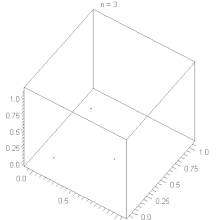George Marsaglia
George Marsaglia | |
|---|---|
| Born | March 12, 1924 |
| Died | February 15, 2011 (aged 86) |
| Nationality | American |
| Alma mater | Ohio State University |
| Scientific career | |
| Fields | Mathematics |
| Institutions | Florida State University Washington State University |
| Doctoral advisor | Henry Mann |
George Marsaglia (March 12, 1924 – February 15, 2011)[1] was an American mathematician and computer scientist.
Research on random numbers

George Marsaglia established the lattice structure of linear congruential generators in the paper "Random numbers fall mainly in the planes",[2] later termed the Marsaglia effect or Marsaglia's theorem.[3] This phenomenon means that n-tuples with coordinates obtained from consecutive use of the generator will lie on a small number of equally spaced hyperplanes in n-dimensional space.[4] He also developed the diehard tests, a series of tests to determine whether or not a sequence of numbers have the statistical properties that could be expected from a random sequence. In 1995 he published a CD-ROM of random numbers, which included the diehard tests.[5]
He also developed some of the most commonly used methods for generating random numbers and using them to produce random samples from various distributions. Some of the most widely used being the multiply-with-carry, subtract-with-borrow, xorshift, KISS and Mother methods for random numbers, and the ziggurat algorithm for generating normally or other unimodally distributed random variables.
Life
He was Professor Emeritus of Pure and Applied Mathematics and Computer Science at Washington State University and Professor Emeritus of Statistics at Florida State University.
Marsaglia died from a heart attack on February 15, 2011, in Tallahassee.[1]
See also
- Linear congruential generator
- Marsaglia polar method
- Multiply-with-carry
- Subtract with carry
- Xorshift
- Ziggurat algorithm
References
- ^ a b "George Marsaglia Obituary". Tallahassee Democrat. 2011-02-22. Retrieved 2017-01-18.
- ^ George Marsaglia (1968). "Random numbers fall mainly in the planes" (PDF). PNAS. 61 (1): 25–28. doi:10.1073/pnas.61.1.25.
- ^ Winton, Charles (2008). Review of Statistical Terminology (PDF). University of North Florida, statistics class notes. p. 20.
- ^ Dr. John Ramirez (2001-07-24). "Random Numbers". Retrieved 2017-01-18.
- ^ "The Marsaglia Random Number CDROM including the Diehard Battery of Tests of Randomness". Florida State University. 1995. Archived from the original on 2016-01-25.
{{cite web}}: Unknown parameter|deadurl=ignored (|url-status=suggested) (help)
Further reading
- Marsaglia, George; Tsang, Wai Wan (1998). The Monty Python method for generating random variables. Vol. 24. pp. 341–350. doi:10.1145/292395.292453.
{{cite book}}:|work=ignored (help)
- Marsaglia, George; Tsang, Wai Wan (2000-10-02). "The Ziggurat Method for Generating Random Variables". Journal of Statistical Software. 5 (8). doi:10.18637/jss.v005.i08.
- George Marsaglia (2003-05-13). "good C random number generator". comp.lang.c newsgroup.
- Marsaglia, Zheng; et al. (2007-03-20). "Axiomatic approaches to formulas for combining likelihoods or evidence". comp.lang.c newsgroup.
{{cite web}}: Explicit use of et al. in:|author=(help)
